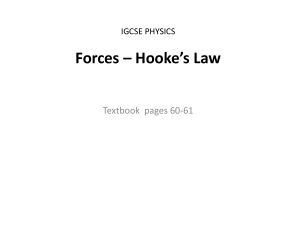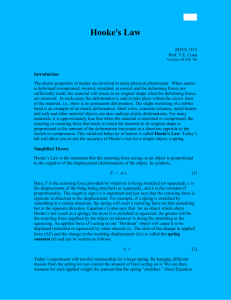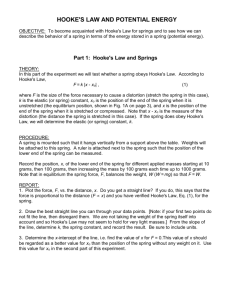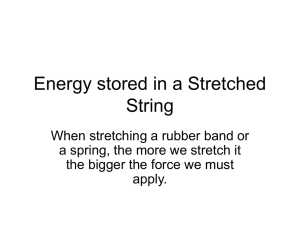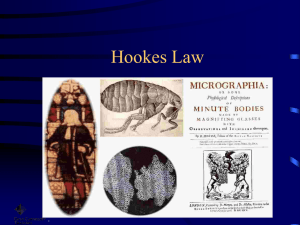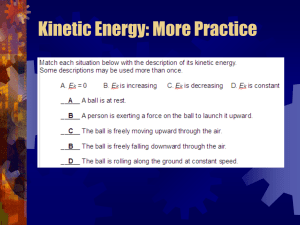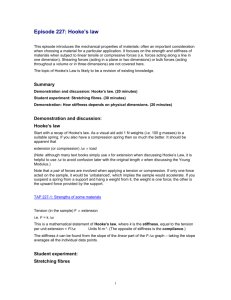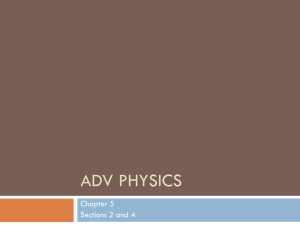Forces: Hooke`s Law PPT
advertisement
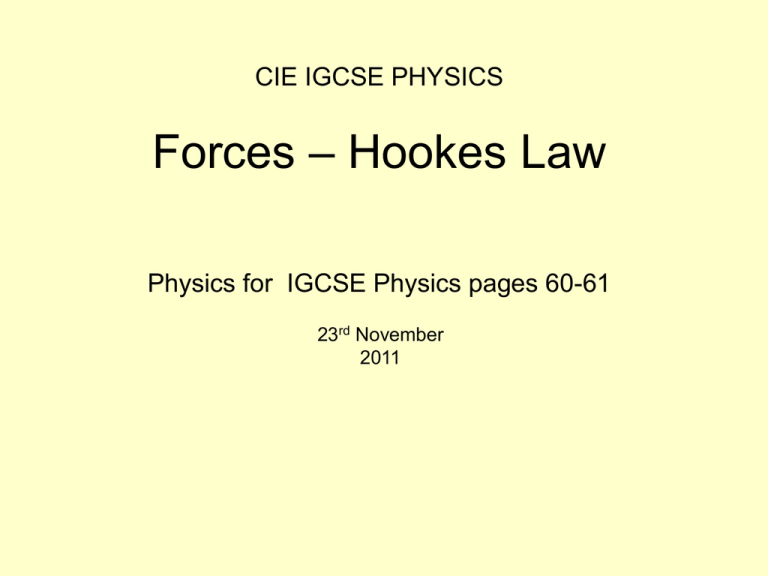
CIE IGCSE PHYSICS Forces – Hookes Law Physics for IGCSE Physics pages 60-61 23rd November 2011 CIE IGCSE Specification 1.5 Effects of Forces Core • State that a force may produce a change in size and shape of a body • Plot extension/load graphs and describe the associated experimental procedure Supplement • Interpret extension/load graphs • State Hooke’s Law and recall and use the expression F = k x F= Force k = spring constant x= extension length • Recognise the significance of the term ‘limit of proportionality’ for an extension/load graph Changing shape Force can also change the shape of an object. A stretching force puts an object such as a wire or spring under tension. A squashing force puts an object under compression. Hooke’s Law Glossary • Elastic materials return to their original shape when the forces on them are removed. • Plastic materials retain their new shape, when forces are removed • Hooke’s Law - The extension of a spring or wire is directly proportional to the force applied provided the limit of proportionality is not exceeded. • Spring constant is the gradient of the force (x- axis) against extension (y-axis) the gradient is the spring constant Units N/m • A stretching force puts an object such as a wire or spring under tension • The limit of proportionality is the is the point beyond which Hooke’s law is no longer true when stretching a material. • The elastic limit is the point beyond which the material you are stretching becomes permanently stretched so that the material does not return to its original length when the force is removed. • A squashing force puts an object under compression. Brittle materials such as glass do not change shape easily and break before noticeably stretching. Resilient materials do not break easily. Elastic materials return to their original shape when the forces on them are removed. Plastic materials retain their new shape. Stretching Springs Experimental procedure: 1. Place the weight holder only on the spring and note the position of the pin against the metre rule. 2. Add 1N (100g) to the holder and note the new position of the pin. 3. Calculate the extension of the spring. 4. Repeat stages 1 to 3 for 2N, 3N, 4N, 5N and 6N. DO NOT EXCEED 6N. spring weights pin metre rule Typical results Pin position with holder only (mm) Added weight or Force (N) Pin position with weight (mm) Extension (mm) 450 1 480 30 450 2 509 59 450 3 541 91 450 4 570 120 450 5 601 151 450 6 629 179 Force (N) Force against extension graph 0 0 Extension (mm) Hooke’s law Hooke’s law states that the extension of a spring force is proportional to the force used to stretch the spring. ‘Proportional’ means that if the force is doubled then the extension also doubles. The line on a graph of force against extension will be a straight AND go through the origin. Force -Extension Graph 12 10 Force (N) 8 6 4 2 0 0 0.2 0.4 0.6 Extension 0.8 1 1.2 Force - Extension Graph stiffer spring 12 10 Force (N) 8 6 4 2 0 0 0.2 0.4 0.6 Extension 0.8 1 1.2 Question A spring of original length 150mm is extended by 30mm by a force of 4N. Calculate the length of the spring if a force of 12N is applied. 12N is three times 4N Therefore the new extension should be 3 x 30mm = 90mm New spring length = 150mm + 90mm = 240mm Elastic limit Up to a certain extension if the force is removed the spring will return to its original length. The spring is behaving elastically. If this critical extension is exceeded, known as the elastic limit, the spring will be permanently stretched. Hooke’s law is no longer obeyed by the spring if its elastic limit is exceeded. The right hand spring has been stretched beyond its elastic limit Force (N) Force against extension graph if the elastic limit is exceeded elastic limit 0 0 Extension (mm) Force Stretching an elastic band An elastic band does not obey Hooke’s law. 0 0 Extension Choose appropriate words to fill in the gaps below: stretched the Hooke’s law states that when a wire or spring is _________ extension is proportional to the load increase in length or _________ force applied. ______ elastic This law is not obeyed if the spring is taken beyond its ______ permanently limit after which it will become _____________ stretched. A ________ rubber band does not obey Hooke’s law. A graph illustrating Hooke’s law will have a line that is straight origin ___________ and passes through the _______. WORD SELECTION: stretched elastic permanently extension origin force rubber straight Online Simulations Effect of forces on motion using a space module Freezeray.com Force combination balloon game - eChalk Electric & Magnetic Forces - 'Whys Guy' Video Clip (3:30mins) - Shows Charged Balloon & Effect of a magnet on a TV screen. Resultant of two forces - Fendt Forces on objects immersed in liquids - NTNU BBC KS3 Bitesize Revision: What is a force Balanced forces Unbalanced forces BBC AQA GCSE Bitesize Revision: Resultant force Types of forces Vector Addition - PhET - Learn how to add vectors. Drag vectors onto a graph, change their length and angle, and sum them together. The magnitude, angle, and components of each vector can be displayed in several formats. Representing vectors - eChalk Vectors & Scalars - eChalk Vector addition - eChalk Vector Chains - eChalk Fifty-Fifty Game on Vectors & Scalars - by KT Microsoft WORD Vector addition - Explore Science Stretching Springs - PhET - A realistic mass and spring laboratory. Hang masses from springs and adjust the spring stiffness and damping. You can even slow time. Transport the lab to different planets. A chart shows the kinetic, potential, and thermal energy for each spring.

